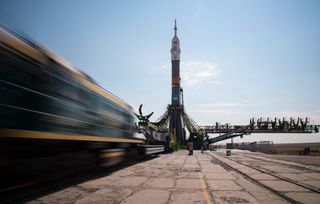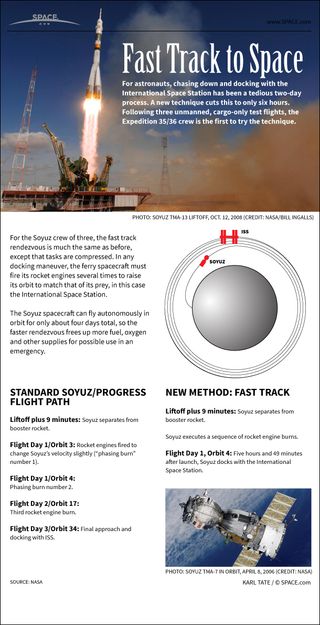Today's Journey to Space Station Will Take Longer Than Usual

Two astronauts and one cosmonaut will begin a two-day journey to the International Space Station tonight (July 6), rather than the more common 6-hour trip.
The three crewmembers are set to launch from the Baikonur Cosmodrome in Kazakhstan at 9:36 p.m. EDT (0136 GMT on July 7). During the two-day flight to the station, the space travelers will test a variety of upgraded systems on the Soyuz MS-01 spacecraft, which has a little more interior living space than a large van.

Two-day trips to the International Space Station were the norm until 2013, when the Russian space agency implemented a new technique to get crewmembers to the station in just 6 hours.
NASA astronaut Kate Rubins, Japanese astronaut Takuya Onishi and Russian cosmonaut Anatoly Ivanishin will orbit Earth 34 times before docking to the station at 12:12 a.m. EDT (0412 GMT) on Saturday, July 9. The crewmembers are scheduled to stay on the station for about four months, returning in October, according to NASA.
During their two days in orbit, the three crewmembers will test out a number of upgrades to the Soyuz spacecraft, NASA officials said in a statement. Those upgrades include "a new digital video transmitter and encoder to send engineering video of the ship's approach to the station for docking, a new relay telemetry capability along with an upgraded Kurs automated rendezvous antenna and an improved satellite navigation system to better calculate the Soyuz's position in space." The spacecraft is now also equipped with upgraded thrusters, additional micrometeoroid debris shielding, redundant electrical motors on the docking probe and additional photovoltaic cells on the spacecraft's solar arrays, the statement said. The upgraded systems have already been tested sans crew.
The first Soyuz crewmembers to make the expedited journey to the station were aboard Expedition 35, in November 2013. A NASA representative told Space.com that during training, Soyuz crewmembers prepare for extended stays in the Russian space vehicle, and there have been previous instances in which a Soyuz crew has had to stay longer than expected inside the vehicle.
Editor's Note: This article previously stated that the launch was on June 6, but it is actually July 6.
Get the Space.com Newsletter
Breaking space news, the latest updates on rocket launches, skywatching events and more!
Follow Calla Cofield @callacofield.Follow us @Spacedotcom, Facebook and Google+. Original article on Space.com.
Join our Space Forums to keep talking space on the latest missions, night sky and more! And if you have a news tip, correction or comment, let us know at: community@space.com.

Calla Cofield joined Space.com's crew in October 2014. She enjoys writing about black holes, exploding stars, ripples in space-time, science in comic books, and all the mysteries of the cosmos. Prior to joining Space.com Calla worked as a freelance writer, with her work appearing in APS News, Symmetry magazine, Scientific American, Nature News, Physics World, and others. From 2010 to 2014 she was a producer for The Physics Central Podcast. Previously, Calla worked at the American Museum of Natural History in New York City (hands down the best office building ever) and SLAC National Accelerator Laboratory in California. Calla studied physics at the University of Massachusetts, Amherst and is originally from Sandy, Utah. In 2018, Calla left Space.com to join NASA's Jet Propulsion Laboratory media team where she oversees astronomy, physics, exoplanets and the Cold Atom Lab mission. She has been underground at three of the largest particle accelerators in the world and would really like to know what the heck dark matter is. Contact Calla via: E-Mail – Twitter
